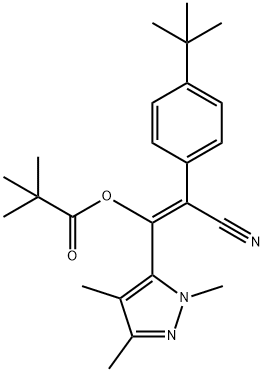Description
Cyenopyrafen is a new acaricide for use in fruit, vegetables, and tea. Its oral LD50 in rats is 2000 mg/kg. Cyenopyrafen is also an inhibitor of mitochondrial complex II (Lummen, 2007).
Uses
Cyenopyrafen is part of the pyrazole class of fungicides and insecticide acting on ticks.
Definition
ChEBI: Cyenopyrafen is a member of the class of pyrazoles that is ethene in which the hydrogens at position 1 have been replaced by p-tert-butylphenyl and cyano groups, while the hydrogens at position 2 have been replaced by pivaloyloxy and 1,3,4-trimethylpyrazol-5-yl groups (the E isomer). A proacaricide (by hydrolysis of the pivalate ester linkage to give the corresponding enol), it was formerly used for the control of mites in fruit, vegetables and tea. It has a role as a proacaricide and an agrochemical. It is a nitrile, a pivalate ester and a member of pyrazoles.
Toxicology
Cyenopyrafen and cyflumetofen have been shown to have very low toxicity to mammals, birds, bees and beneficial insects, including predatory mites. They have some toxicity to fish and aquatic invertebrates, but pose minimal risk because they are rapidly degraded in water and soil.
Mode of action
Cyenopyrafen and cyflumetofen are pro-insecticides that are metabolized to corresponding enol products that inhibit mitochondrial electron transport complex II, leading to rapid paralysis and death due to cellular energy starvation. Resistance has not yet been reported.


